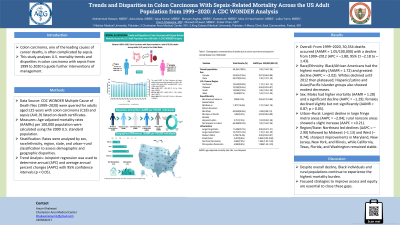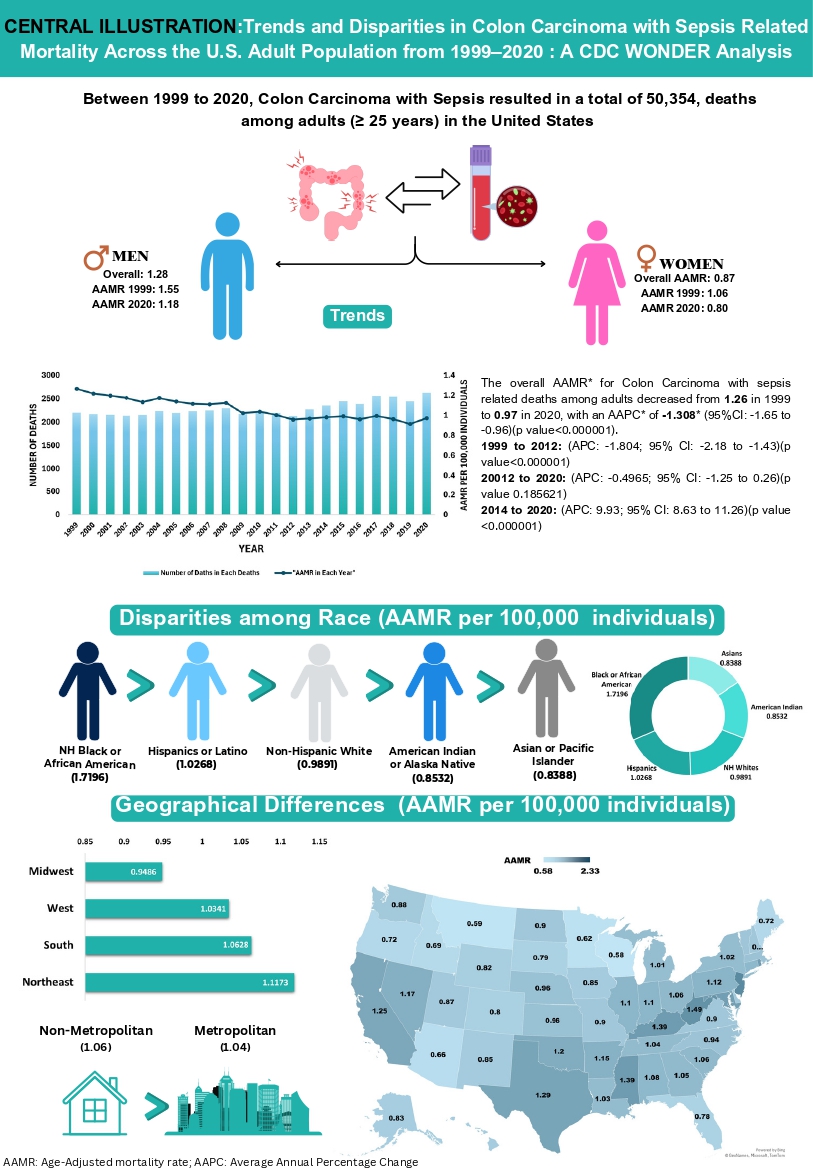Tuesday Poster Session
Category: Colon
P4551 - Trends and Disparities in Colon Carcinoma With Sepsis-Related Mortality Across the US Adult Population from 1999–2020: A CDC WONDER Analysis

- AK
Anum Khakwani, MD
Charleston Area Medical Center
Charleston, WV
Presenting Author(s)
1Nishtar Medical University, Multan, Punjab, Pakistan; 2Charleston Area Medical Center, Charleston, WV; 3King Edward Medical University, Lahore, Punjab, Pakistan; 4Mercy Clinic East Communities, Festus, MO
Introduction: Colon carcinoma, one of the leading causes of cancer deaths, is often complicated by sepsis. This study analyzes U.S. mortality trends and disparities in colon carcinoma with sepsis from 1999 to 2020 to guide further interventions of management.
Methods:
Using CDC WONDER data (1999–2020), we analyzed deaths in adults aged 25+ with ICD-10 codes C18 (colon carcinoma) and A41.9 (sepsis). Age-adjusted mortality rates (AAMRs) per 100,000 were stratified by sex, race/ethnicity, region, state, and urban-rural classification. Joinpoint regression calculated annual percent changes (APCs) and average annual percent changes (AAPCs) with 95% CIs (p< 0.05).
Results:
From 1999–2020, 50,354 deaths occurred (AAMR=1.05/100,000), with a decline from 1999–2012 (APC=-1.80, 95% CI: -2.18, -1.43). Black or African American individuals (AAMR=1.72) had the highest burden and largest decline (AAPC=-2.02, 95% CI: -2.39, -1.64), followed by White individuals (AAMR=0.99; AAPC=-1.11, 95% CI: -1.48, -0.74; 1999–2012: APC=-1.71, 95% CI: -2.11, -1.31; 2012–2020: stable). Asian or Pacific Islander (AAMR=0.84; AAPC=-1.10, 95% CI: -1.85, -0.35) and Hispanic or Latino individuals (AAMR=1.03; 2005–2020: APC=-0.98, 95% CI: -1.90, -0.06) also declined. Large fringe metro areas (AAMR=0.99; AAPC=-2.04, 95% CI: -2.45, -1.63) had the sharpest drop, followed by medium (AAMR=0.95; AAPC=-0.69, 95% CI: -1.06, -0.32) and small metro (AAMR=1.07; AAPC=-0.82, 95% CI: -1.27, -0.38), while rural noncore areas (AAMR=1.07; AAPC=0.21, 95% CI: -0.27, 0.69) rose slightly. Males showed a decline (AAMR=1.28; AAPC=-1.29, 95% CI: -1.52, -1.06); females (AAMR=0.87; AAPC=-1.17, 95% CI: -2.49, 0.17) did not. The Northeast (AAMR=1.12; AAPC=-2.90, 95% CI: -3.15, -2.64) led declines, followed by Midwest (AAMR=0.95; AAPC=-1.13, 95% CI: -1.49, -0.78) and West (AAMR=1.03; AAPC=-0.74, 95% CI: -1.14, -0.34). Maryland (AAPC=-3.88), New Jersey (-2.94), New York (-2.92), and Illinois (-1.61) improved; California, Texas, Florida, and Washington stayed stable.
Discussion:
Colon carcinoma-sepsis mortality fell from 1999–2020, but disparities remain in race/ethnicity (highest in Black or African American individuals), sex (stable in females), urbanization (rising rural trends), and region/state (stable in California, Texas). Interventions to improve rural and female healthcare access are needed.


Disclosures:
Muhammad Hassan, MBBS1, Azka Aisha, MBBS1, Aqsa Komel, MBBS1, Maryam Asghar, MBBS1, Haseeb Ali, MBBS1, Moiz Ul Haq Hashmi, MBBS1, Laiba Yumn, MBBS1, Anum Khakwani, MD2, Muneeb Khawar, MBBS3, Zubair Khan, MD4. P4551 - Trends and Disparities in Colon Carcinoma With Sepsis-Related Mortality Across the US Adult Population from 1999–2020: A CDC WONDER Analysis, ACG 2025 Annual Scientific Meeting Abstracts. Phoenix, AZ: American College of Gastroenterology.
